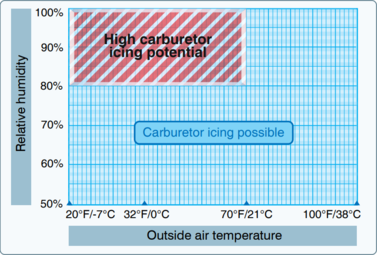Carburetor icing
Carburetor icing, or carb icing, is an icing condition which can affect any carburetor under certain atmospheric conditions. The problem is most notable in certain realms of aviation.
Carburetor icing is caused by the temperature drop in the carburetor, as an effect of fuel vaporization, and the temperature drop associated with the pressure drop in the venturi. If the temperature drops below freezing, water vapor will freeze onto the throttle valve, and other internal surfaces of the carburetor. The Venturi effect can drop the ambient air temperature by 70 absolute degrees Fahrenheit (F), or 38.9 absolute degrees Celsius (C). In other words, air at an outside temperature of 100 degree F, can drop to 30 degrees F in the carburetor. Carburetor icing most often occurs when the outside air temperature is below 70 degrees F (21 degrees C) and the relative humidity is above 80 percent.[1]
Unfortunately, the warm air temperature often causes pilots of aircraft to overlook the possibility of carb icing. The ice will form on the surfaces of the carburetor throat, further restricting it. This may increase the Venturi effect initially, but eventually restricts airflow, perhaps even causing a complete blockage of air to the carburetor. The engine begins to run more rich as ice formation increases. Without intervention (carb heat or leaning) this can only continue until the mixture is outside of the "chemically correct" range for combustion. Icing may also cause jamming of the mechanical parts of the carburetor, such as the throttle, typically a butterfly valve.
While it applies to all carburetors, carburetor icing is of particular concern in association with piston-powered aircraft, especially small, single-engine, light aircraft. Aircraft powered by carbureted engines are equipped with carburetor heat systems to overcome the icing problem. In cars, carburetor icing can occasionally be a nuisance. The inlet manifold and parts of the carburetor often have warm water from the cooling system or exhaust gas circulating through them to combat this problem. Motorcycles can also suffer from carburetor icing, although some engine designs are more susceptible to it than others. Air-cooled engines may be more prone to icing, due to the absence of warm coolant circulating through the engine.
See also[]
References[]
- ^ Jump up to: a b Pilot's Handbook of Aeronautical Knowledge, FAA-H-8083-25B (PDF). US Dept. of Transportation, FAA. 2016. pp. 7-8–7-10.
- Weather hazards to aircraft
- Engine problems
- Carburettors
- Aviation stubs

